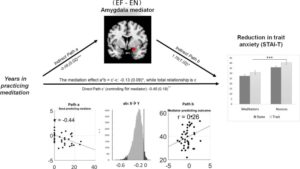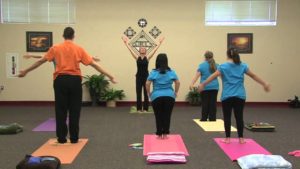Reduce Anxiety and Depression with Mindfulness
By John M. de Castro, Ph.D.
“Being unwilling to experience negative thoughts, feelings, or sensations is often the first link in a mental chain that can lead to automatic, habitual, and critical patterns of mind becoming re-established. By accepting unpleasant experiences, we can shift our attention to opening up to them. Thus, “I should be strong enough” shifts to “Ah, fear is here,” or “Judgment is present.”—Zindel Segal,
Meditation training has been shown to improve health and well-being. It has also been found to be effective for a large array of medical and psychiatric conditions, either stand-alone or in combination with more traditional therapies. Meditation practice has been found to improve the regulation of emotions and reduce difficult emotional states such as anxiety and depression.
A characterizing feature of anxiety disorders is recurring thoughts, such as impending disaster, that they may realize are unreasonable, but are unable to shake. Indeed, Mindfulness practices have been shown to be quite effective in relieving anxiety. Anxiety often co-occurs with depression and mindfulness training is also effective for treating depression. Anxiety disorders and depression have generally been treated with drugs. But there are considerable side effects and these drugs are often abused. So, there is a need to develop alternative treatments. Since mindfulness- based treatments are relatively new, it makes sense to step back and summarize what is known regarding the effectiveness of mindfulness training for anxiety disorders and for depression.
In today’s Research News article “Mindfulness-Based Interventions for Anxiety and Depression. The Psychiatric clinics of North America.” (See summary below or view the full text of the study at: https://www.ncbi.nlm.nih.gov/pmc/articles/PMC5679245/ ), Hofmann and Gomez review and summarize the published research literature on the effectiveness of mindfulness training for the relief of anxiety and depression.
They report that randomized controlled trials found that Mindfulness-Based interventions including the Mindfulness-Based Stress Reduction (MBSR), the Mindfulness-Based Cognitive Therapy (MBCT), Dialectical Behavior Therapy, and Acceptance and Commitment Therapy treatment programs were “moderately-to-largely effective at reducing anxiety and depression symptom severity among individuals with a broad range of medical and psychiatric conditions.” They also report that these programs are effective whether provided in person or over the internet. They are consistently more effective than health education, relaxation training, and supportive psychotherapy, but equivalently effective as Cognitive Behavioral Therapy (CBT).
Hence, accumulating controlled research has built a strong case for the use of Mindfulness-Based Interventions for the treatment of anxiety and depression. Since, these treatments are generally safe and effective with little if any side effects, they would appear to be preferable to pharmacological treatments.
So, reduce anxiety and depression with mindfulness.
“Mindfulness keeps us focused on the present, and helps us meet challenges head on while we appreciate all our senses absorb. On the contrary, focus on the future contributes to anxiety, while perseveration on the past feeds depression. Far too often when we look to the future, we ask ourselves, “What if,” and the answer we give ourselves is often a prediction of a negative result.” – Vincent Fitzgerald
CMCS – Center for Mindfulness and Contemplative Studies
This and other Contemplative Studies posts are also available on Google+ https://plus.google.com/106784388191201299496/posts and on Twitter @MindfulResearch
Study Summary
Hofmann, S. G., & Gómez, A. F. (2017). Mindfulness-Based Interventions for Anxiety and Depression. The Psychiatric clinics of North America, 40(4), 739-749.
Key Points
- Research on mindfulness-based interventions (MBIs) for anxiety and depression has increased exponentially in the past decade. The most common include Mindfulness-Based Stress Reduction (MBSR) and Mindfulness-Based Cognitive Therapy (MBCT).
- MBIs have demonstrated efficacy in reducing anxiety and depression symptom severity in a broad range of treatment-seeking individuals.
- MBIs consistently outperform non-evidence-based treatments and active control conditions, such as health education, relaxation training, and supportive psychotherapy.
- MBIs also perform comparably to cognitive-behavioral therapy (CBT). The treatment principles of MBIs for anxiety and depression are compatible with those of standard CBT.
Synopsis
This article reviews the ways in which cognitive and behavioral treatments for depression and anxiety have been advanced by the application of mindfulness practices. Research on mindfulness-based interventions (MBIs) has increased exponentially in the past decade. The most common include Mindfulness-Based Stress Reduction (MBSR) and Mindfulness-Based Cognitive Therapy (MBCT). MBIs have demonstrated efficacy in reducing anxiety and depression symptom severity in a broad range of treatment-seeking individuals. MBIs consistently outperform non-evidence-based treatments and active control conditions, such as health education, relaxation training, and supportive psychotherapy. MBIs also perform comparably to cognitive-behavioral therapy (CBT). The treatment principles of MBIs for anxiety and depression are compatible with those of standard CBT.
https://www.ncbi.nlm.nih.gov/pmc/articles/PMC5679245/





